Samsung has gone full bore to ensure its flagship Galaxy S21 Ultra 5G scorches the competition in 2021. And it needs to after a loss of market share in 2020 during the pandemic.
According to one survey, Samsung began last year about 8 per cent ahead of Apple, by the end the margin had dropped to 2.23 per cent. That’s a big gain for Apple given Samsung’s share is bolstered by mid-range and cheaper handsets that Apple doesn’t produce.
Samsung also faces stiff competition at the high end in 2021 by Oppo and Xiaomi so it needs plenty of market pull. The S21 range is the Korean phone maker’s answer to this.
I’ve been trialling the premium Galaxy S21 Ultra 5G, the most lavish of this year’s S21 range, the others being the S21 5G and S21+ 5G.
The Ultra is fast, attractive, feature packed, and has a five-lens camera system with lots of photography options.
Before getting engrossed in detail, the Samsung Galaxy S21 Ultra 5G is expensive kit. At $1849, it costs the same as its main rival, the iPhone 12 Pro Max. Both offer 128GB internal storage. Apple charges more if you want extra storage so the Samsung and Apple models with 256GB storage are $1949 and $2019, and 512GB models are $2149 and $2369.
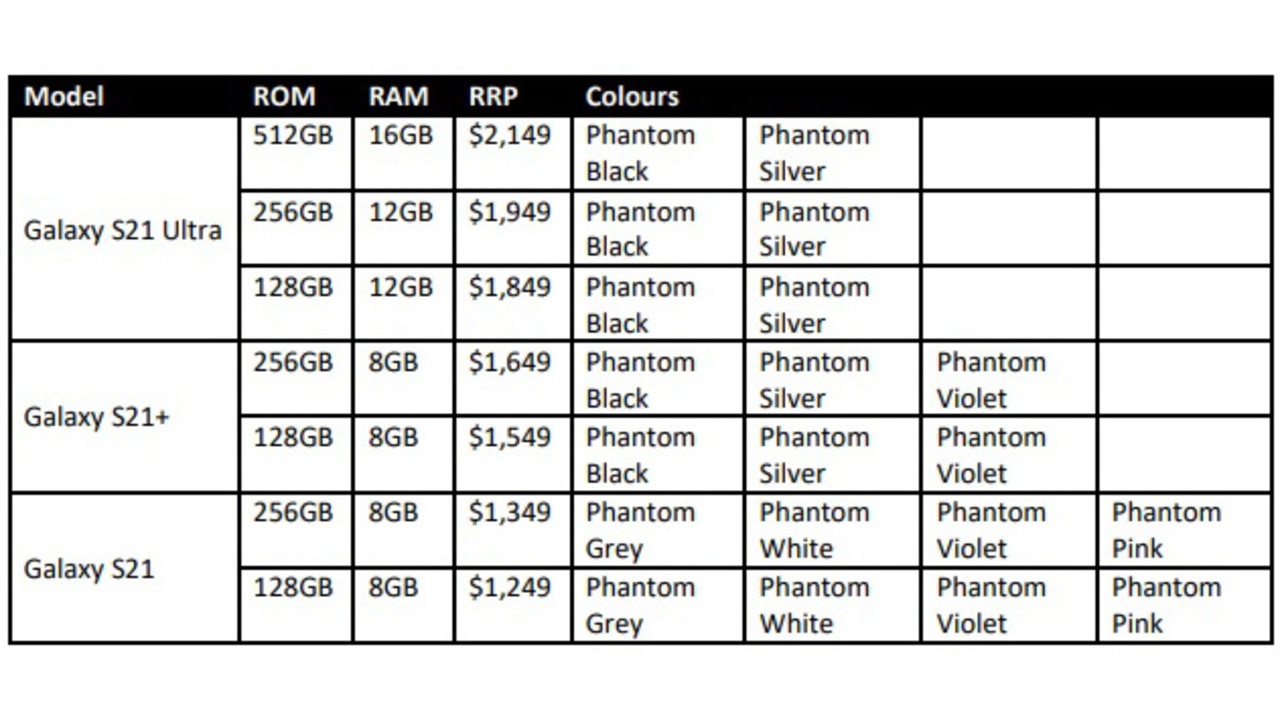
I used to worry about enough storage in the days of phones with 16GB, 32GB and 64GB, but frankly, 128GB is enough for me in an era where much of our mobile media is stored in the cloud.
There are three things missing from this phone: a 3.5mm audio jack, support for expandable storage such as a microSD card, and a charger.
Apple last year also omitted a charger with iPhone 12. So you either pay extra for a proprietary charger, or learn the charging requirements of these phones and buy your own. Based on 2020, you need a 25-watt charger for fast charging, and 45-watt charger for super fast charging. I couldn’t get super fast charging to work with 45W and 60W chargers so you may be stuck with buying Samsungs if you want that. Make sure your charging mode is toggled on in the settings.
If you don’t own a Samsung phone charger, it might be time to invest in a new-age gallium nitride (GaN) charger which is about half the size of a conventional one. They’re available with multiple USB-C connectors that charge several devices at once.
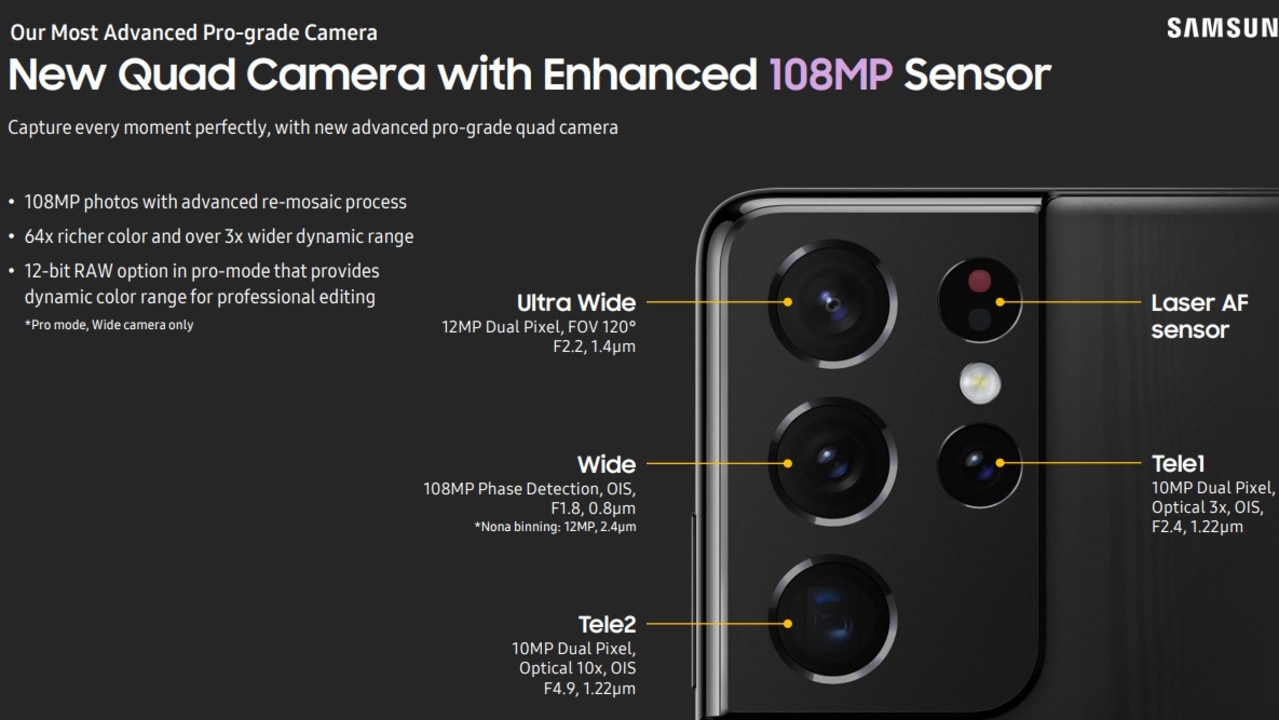
The Ultra is a big phone with a big 6.8-inch AMOLED display, fast processor, very bright (1500 nitt) screen and lots of battery capacity, some 5000 milliampere hours. Screen resolution on this model is QHD+, about half the pixels of 4K and in my view ideal for a phone. 4K squanders battery for a marginal benefit in screen resolution on a phone-sized screen.
Battery life is amazing. Using our standard test of 1080p video running at 50 per cent brightness, this huge battery delivered 23 hours 13 mins before running out of juice.
I also ran the AnTuTu test on the phone’s Exynos 2100 processor. It scored 606071 which is up there with the best, bettered only by the latest Vivo, Asus ROG and Oppo flagships in Android, and Apple iPhone 12 and iPad Pro models. The difference in overall scores between these isn’t big.
The screen can scale up its refresh rate from 10Hz to 120Hz. That’s a measure of how fast it displays images. 120Hz is great when playing faster action games, but a slower rate offers a power saving.

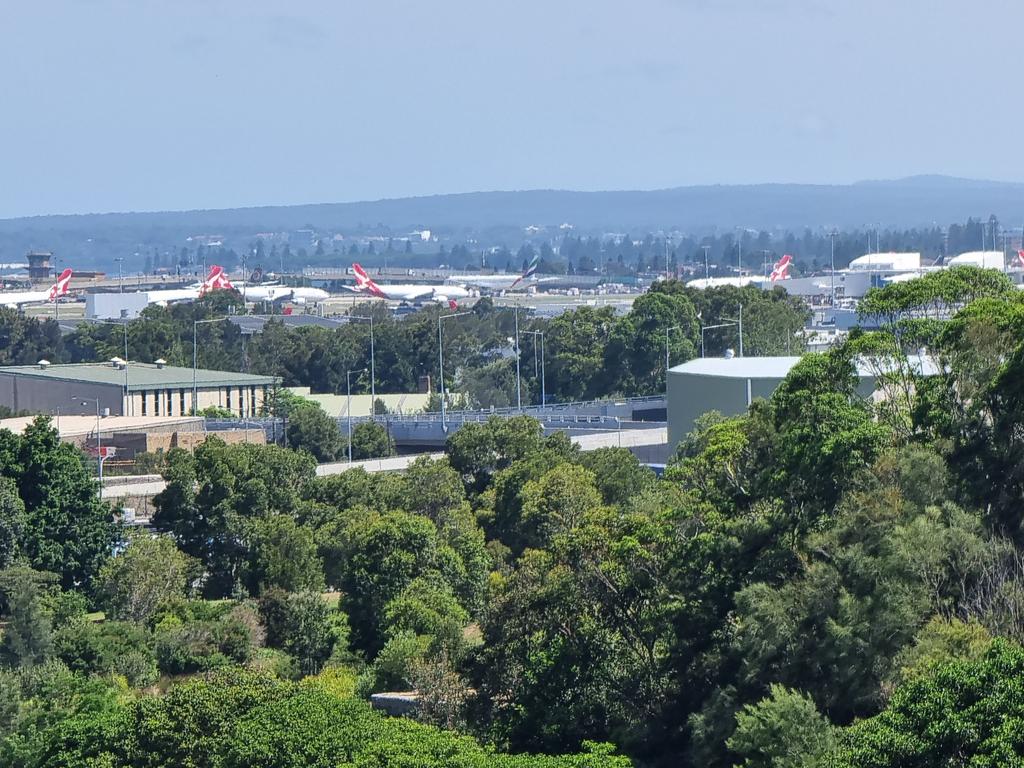
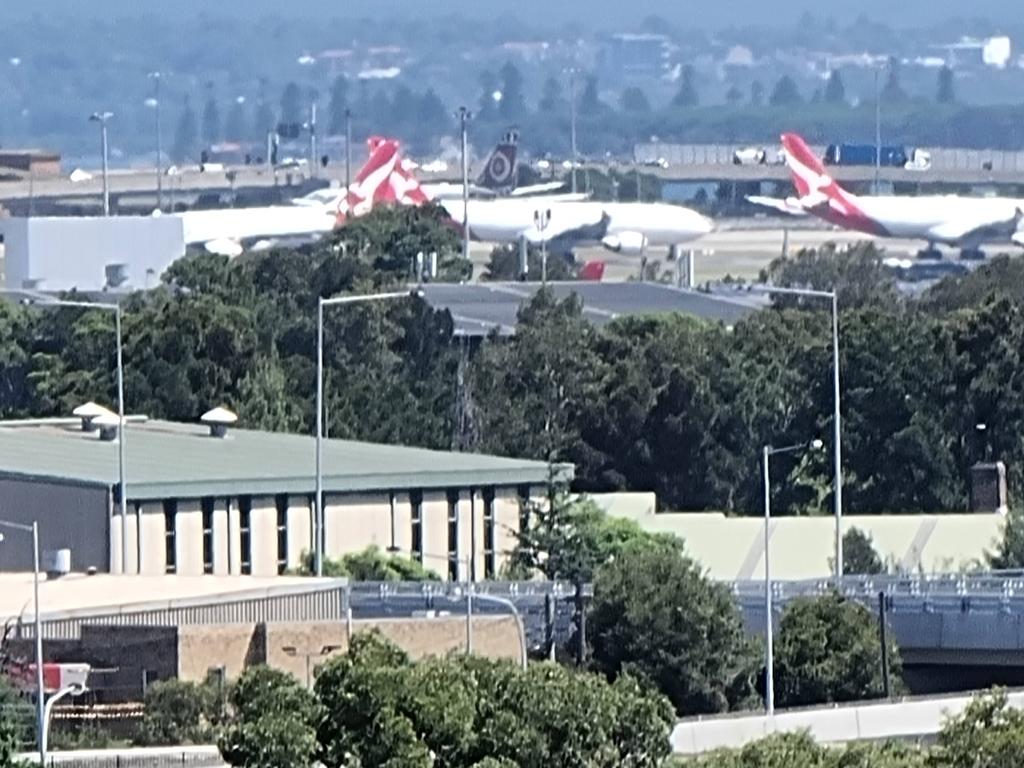

The Ultra delivers Samsung standard features such as 10-watt wireless charging and reverse charging. The phone itself can charge compatible Qi devices such as earbuds.
The Ultra supports Samsung DeX, which means it can emulate a desktop computer when you connect the phone to a monitor using a USB-C to HDMI cable. When travelling, you can pack a Bluetooth keyboard and mouse and DeX cable, and use your hotel TV as a computer screen – no laptop required. DeX to me is a much underrated feature.
The Ultra also supports Samsung’s S-Pen stylus. That’s a first because the S-Pen only worked previously with Galaxy Note phones, not the S range. The S-Pen doesn’t come with the Ultra so you need to buy it separately. Additionally you can’t dock it inside the phone so you’ll have to buy a case that lets you carry the S-Pen.
S-Pen air commands work with the S21 Ultra, a menu displays when you hover the S-Pen and press the button. You can use the stylus to create notes, access the calendar, and write, draw and sketch.
This phone has amazing audio. When I first played a Spotify track, I thought there was a speaker in the room. There’s a speaker at the bottom and sound emanates from the phone speaker at top too.
The S1 line is 5G-capable, but none of these Samsung phones support the high frequency mmWave that will come to market after being auctioned to telcos early this year.

The S21 range has one inadvertent, useful feature for the pandemic, the in-screen fingerprint reader. Masks have rendered face logins on phones useless. If you have an iPhone, you have to login with your code when masked.
The S21 phones’ in-screen fingerprint reader work in a flash. It may be good luck rather than good management, but it makes authentication easier in this COVID era.
The Ultra’s big ticket item is its camera system. It’s a showcase of Samsung’s best camera technology.
There are five lenses on the back: a 12MP ultra wide, a 108MP wide, a 10MP 10x optical zoom lens, 10MP 3x optical zoom lens, and a laser sensor for fast autofocusing.

Zoom is the prime feature on this phone. The camera app menu offers quick switching between 0.06x for macro shots, which look great, and 1.0x, 2.0x, 4.0x, 10x, 30x and 100x, achieved through a combination of lenses. Higher rates are hybrid/digital zoom.
1.0x photos are great and even photos up to 10x optical zoom look very good. You get decent shots at 30x, although clarify and crispness suffers a little. 30x is as far as I’d go for quality images.
These zoom options change with modes, for example night mode offers only up to 10x zoom and options are limited for portrait shots.
The 100x zoom might be a good headline. Samsung also rolled this capability out last year. However, the result when blown up is a photo with thick, unattractive lines, graininess, artefacts and noise. There may be a need for 100x in exceptional circumstances. You might be touring Japan when Mt Fuji erupts in the distance. That would be something – the last time was 1707.
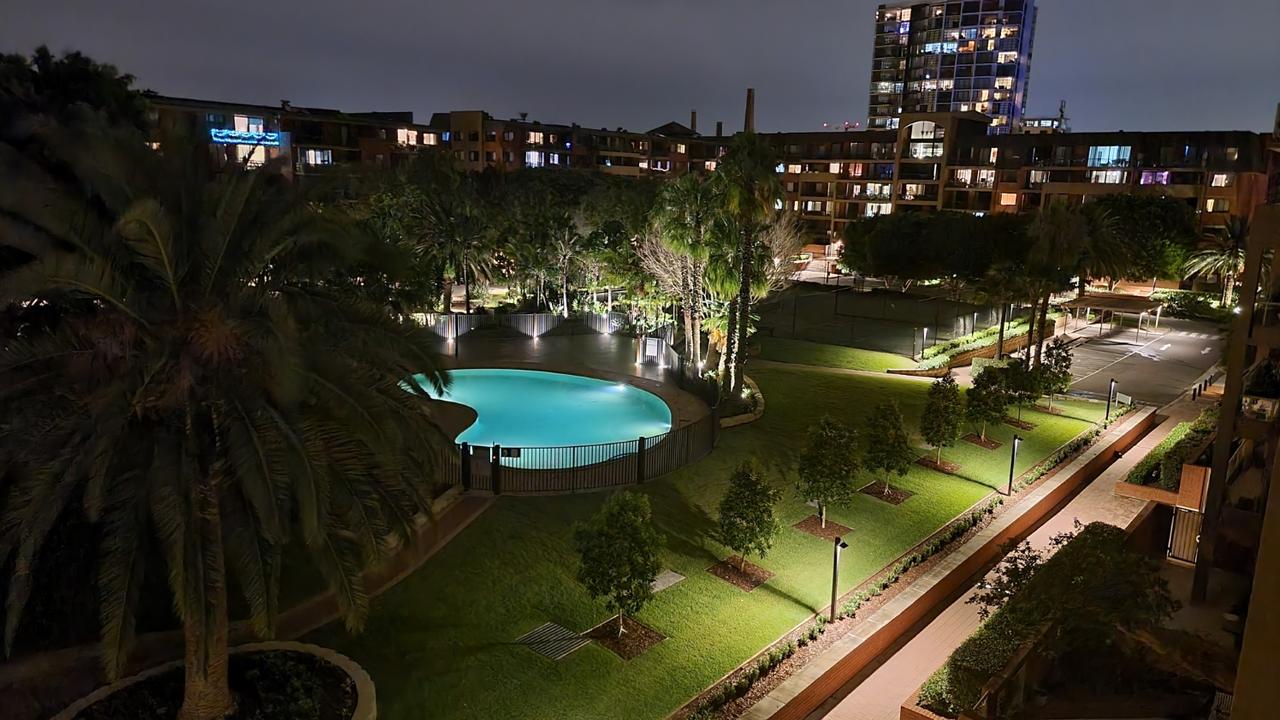
I’ve reported before that there are regular cameras that take great shots at 100x, such as the Nikon Coolpix P1000, but it’s a heavy camera with a big lens.
For small smartphones 100x with decent quality is a huge ask. I’m not saying it’s impossible. The most likely method is to bend the incoming light 90 degrees and to send it up and down the length of the phone, progressively magnifying it with internal lenses. This capability is not there yet.
But it was amazing to use 10x and 30x and shoot images of detail that I could barely see in the distance with the naked eye.
The same applies to night mode. You can snap reasonable night images with the standard photo app, but the dedicated night mode clearly showed areas around me that otherwise are almost pitch black.
The Ultra has a decent 40MP selfie camera that takes great wide shots.


Of the different available shooting modes, I loved the “director’s view” which shows thumbnails of three back facing lenses and the selfie camera image in one screen. This is a vlogger’s dream. You can shoot video with an image of you narrating in the top corner picture-in-picture, while you swap lenses showing the main screen at different resolutions.
Apple demonstrated a similar capability at its Worldwide Developers’ Conference in 2019 with a third party app called AVCapture, that I no longer can find in the App Store. Dualgram is an alternative.
With Samsung, the feature is built into the main camera app and worth using.
In general the cameras take beautiful images, although occasionally a zoomed-in photo can look a tad over processed and not so sharp, and colours over saturated.
The Samsung Galaxy S21 is a terrific phone albeit it’s a big phone for some, it’s feature rich, has excellent battery life, a bright high resolution display with a fast refresh rate for gaming – the capabilities go on and on. The S21 range and Ultra in particular will give the 2021 market a big shake.
